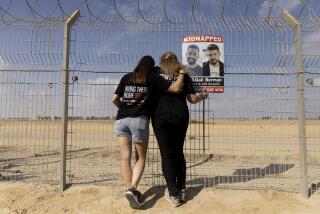Fighting governments and guerrillas
Today, Carter and Korb close their Dust-Up with a discussion on the kinds of conflicts the U.S. military can expect to fight in the future. Previously, they discussed of the armed forces, Adm. William J. Fallon’s with the administration, gleaned from torture and the Air Force .
A military that can handle all kinds of war
By Phillip Carter
Larry,
America has an awful track record of studying history, predicting future patterns in warfare and then developing a military that will be ready for the next war. Perhaps the only example I can readily think of is the Persian Gulf War, in which a U.S. military built to fight the Soviet Union in Europe turned out to be pretty good at desert warfare too, not least because the Army’s premier training center sits in the California desert. For nearly every other conflict -- both world wars, Korea, Vietnam, Bosnia and now Iraq -- we incorrectly judged the future of warfare and then sent the wrong kind of military to fight.
Within the Army and the broader defense community, there is a debate raging today over two basic questions: What the next war will look like? And how should the military train, equip and organize itself to fight it?
I am going to punt on the first question, partly because I don’t feel qualified to answer it, and partly because I think the world is such an uncertain place that we cannot predict (at least, not with any fidelity) what future wars will look like. Pentagon strategy documents chart every current and emerging threat out there, from rising peer competitors such as China to global terror networks to natural disasters and the scarcity of resources. The only common denominator these scenarios share is uncertainty.
Assuming that uncertainty, how then should the military prepare? As someone who has served and who continues to work on military manpower and procurement issues, this is the more interesting debate for me.
Historically, the Army has trained for big wars and thought of small wars as lesser kinds of conflict, hoping that the skills for major combat operations would trickle down well to things such as counterinsurgency. Our fighting in the Iraq and Afghanistan wars, particularly during their first few years, illustrates the folly of this idea. To paraphrase Army Lt. Col. John Nagl, one of this generation’s leading defense intellectuals, counterinsurgency is the graduate level of warfare. It involves a fundamentally different approach, in which the use of force is highly constrained and the support of the local population is the objective (as opposed to the capture of terrain or destruction of the enemy). A military trained for combat operations cannot easily adjust to this modus operandi. The military must rethink its approach to training, organizing and equipping for warfare, and abandon the one-size-fits-all approach.
I think the answer is to develop a “full spectrum” capability -- and not just for the military, but more broadly for the United States government. A great deal of attention has been paid to the Army’s new counterinsurgency manual and its new doctrine, which gives equal weight to the importance of counterinsurgency and major combat operations. But the Army cannot go it alone -- it needs support from the other military services and government agencies, including the departments of State, Justice and Homeland Security and the Central Intelligence Agency. We need to develop an integrated vision for how the United States (not just the Army or Marines) will act in future wars, and then develop the doctrine and organizations to do so.
Critical here will be developing flexible organizations that can handle situations on the spectrum ranging from peace to war. In the procurement arena, this means investing in the kinds of “dual-use” or “multi-use” gear that support both counterinsurgency and combat operations. The Army and Marines will still need armored vehicles, but it may not need as many artillery cannons. Similarly, the Air Force will still need fighter aircraft to maintain air superiority, but it may need a lot more transport aircraft to deliver troops and supplies, as well as air and space surveillance capabilities that enable commanders to see whatever is facing them.
There is some risk in overlearning the lessons of Iraq and Afghanistan. Some critics compare the U.S. military with the Israeli military, charging that the latter overlearned from its experiences patrolling the West Bank and Gaza Strip, leaving itself unprepared to launch an offensive campaign against Hezbollah in 2006. There are serious problems (PDF) with this argument, but I think it’s worthwhile asking how we should balance readiness for counterinsurgency with readiness for war against a large nation such as China. The only way to ensure that we’re ready for the next war is to build a military that can flexibly respond to different kinds of conflict.
Phillip Carter practices government contracts law with McKenna Long & Aldridge in New York City. He previously served as an Army officer for nine years, deploying to Iraq in 2005-06 as an embedded advisor with the Iraqi police in Baqubah.
Building the world’s first responder
By Lawrence J. Korb
After five years of war in Iraq and six-plus in Afghanistan, the United States military is facing a crisis not seen since the end of the Vietnam War. Equipment shortages, manpower shortfalls, recruiting and retention problems and misplaced budget priorities have resulted in a military barely able to meet the challenges America faces today and dangerously ill-prepared to handle the challenges of the future.
As operations in Iraq eventually draw to a close, we must plot a new strategic direction for our nation’s military. Maj. Gen. Robert Scales, former head of the Army War College, has noted that the current crisis in Iraq presents the “opportunity to transform ourselves as we rebuild.” As Phil points out, we have an awful track record of getting it right.
Moving forward, we must keep four things in mind.
First, we must not overestimate the utility of military force. In the wake of Iraq, the U.S. should undertake a much more cautious approach to international military engagements. We must recognize that using military force has consequences that are difficult to predict and even harder to manage. Too often, military force is pointed to as the first resort to deal with complex international problems rather than the last resort. We must adopt a more measured approach.
Second, however, our experiences of the last two decades indicate that America’s military will not get much rest. Since the United States is still the sole global superpower, it will continue to be the guarantor of global security and will be frequently called upon to act, not just in a conventional military capacity but in the form of a global first responder.
Third, irregular or nontraditional conflicts are the fights we will most likely engage. Although the U.S. military must always be prepared to engage and defeat another military on the battlefield, our experiences since the end of the Cold War indicate that our armed forces are much more likely to engage in nontraditional operations, such as responding to the effects of tragic natural disasters, supporting peacekeeping and stability operations and striking at terrorist training camps.
Fourth, responding to crises and disasters will be a major function of our military in the future. Instead of resisting this role, we should embrace it. The role of a global first responder will not only help to alleviate suffering but will improve the global image of America and help the U.S. build better ties around the world.
The increasing effects of climate change will have a significant effect on our national security. Storms of a catastrophic nature, rising sea levels, increased drought and other natural calamities will become all the more frequent, facilitating refugee crises and regional instability.
An effective action can make a tremendous difference. Following the December 2003 tsunami, the U.S. eventually sent 15,000 troops, a carrier task force, a Marine expeditionary force and a flotilla of ships and aircraft to the affected regions in the Indian and Pacific oceans. The response to the tsunami disaster made a tremendous difference in alleviating the humanitarian crisis and assisting in the region’s recovery. But it also had a tremendous effect on the United States’ image. Following the disaster, according to the Pew Research Center, 79% of Indonesians said they had a more favorable view of the U.S.
To address these challenges, we must transform our armed forces by recognizing that our military is lopsided. While our troops combat insurgents who lack uniforms, our military is still spending the vast majority of its budget on programs that have little or no relevance to this reality. We must take the following three steps:
First, we must match our resources with our priorities -- cut outdated pre- 9/11 weapons systems and invest in expanding the size of our ground forces.
Second, we must seek to better integrate all elements of our national power, because addressing these challenges is just as much a diplomatic and foreign-assistance effort as it is a military effort. As we have learned in Iraq and Afghanistan, quality reconstruction and development programs can be vital to overall success, and we must do more to improve these efforts.
Finally, we must strengthen alliances and partnerships and look to develop global security networks. One example of an innovative military effort is the Navy’s “1,000-ship Navy” concept. This idea would leverage the fleets of allied or friendly countries to create a network of navies to better police the world’s oceans.
Phil and I agree that transforming our military to meet the challenges of the 21st century will be difficult. It will require a willingness to change and will demand leadership from the military, Congress and the president. To meet current challenges and future threats, it is vital that we build a new, modern force to ensure the safety, security and strength of the United States.
Lawrence J. Korb, assistant secretary of Defense in the Reagan administration, is a senior fellow at the Center for American Progress and a senior advisor to the Center for Defense Information.
| | | | Day 5
More to Read
A cure for the common opinion
Get thought-provoking perspectives with our weekly newsletter.
You may occasionally receive promotional content from the Los Angeles Times.










